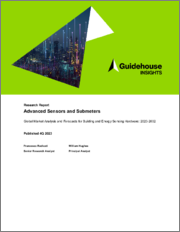
세계의 첨단 센서 및 서브미터 시장 규모는 2023년 180억 달러에서 2032년에 289억 달러에 달하고, CAGR로 5.4%의 성장이 예측됩니다.
세계의 첨단 센서 및 서브미터 시장에 대해 조사 분석했으며, 사무실, 공장, 창고, 교육 현장 등 상업 및 산업 건축물에 사용되는 첨단 센싱 및 서브미터 기술에 초점을 맞추어, 주요 센서 및 서브미터의 주요 유형별 동향과 빌딩 자동화 시스템 및 분산형 에너지 자원 등 신기술과의 통합 방법에 대한 리뷰 등을 제공합니다.
KSMSensing technologies provide information on the conditions inside a building: the number of people present, the climate conditions, or how the building's electrical system is functioning. As connectivity technology has improved, these sensors have been able to connect to building automation systems and inform how different systems impact one another. One example is using occupancy data to communicate to facilities teams whether to clean and service an area, or to shut off the HVAC system.
In office settings, these questions have become more important since the COVID 19 pandemic and the switch to hybrid working. With workforces present only part of the time, companies have become more aware of how they use their working spaces and have adjusted their cleaning and HVAC systems accordingly. In many cases, they have also reduced the square footage of their office space, but upgraded to higher quality space, with the goal of keeping workers happy on the days they work in person.
This Guidehouse Insights study focuses on advanced sensing and submetering technology used in commercial and industrial (C&I) buildings, including offices, factories, warehouses, and educational settings. It reviews the trends among the most prominent types of sensors and submeters, and how they integrate with new technologies such as building automation systems and distributed energy resources. Forecasts for advanced sensor and submeter solutions extend from 2023 to 2032 and are segmented by five global regions: North America, Europe, Asia Pacific, Latin America, and Middle East & Africa. Guidehouse Insights expects that global revenues for advanced sensors and submeters will grow from $18.0 billion in 2023 to $28.9 billion in 2032, at a compound annual growth rate (CAGR) of 5.4%.